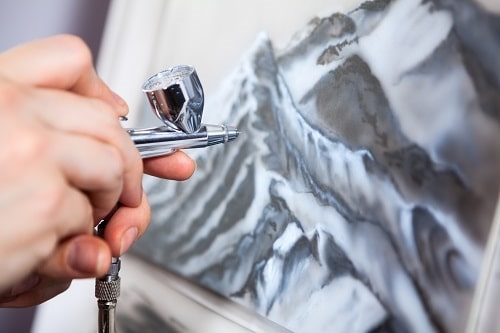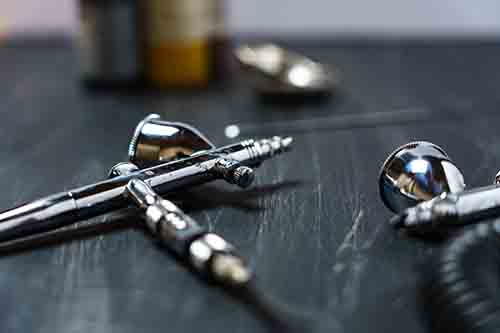All Products are in stock
and shipped from France.
Delivery within 48 hours.
and shipped from France.
Delivery within 48 hours.
 Artistic paints to apply with an airbrush
Artistic paints to apply with an airbrush
Artistic drawing with an airbrush is a rather vague term, but one that excludes certain practices. We will therefore make a summary to try to pin down the definition of the airbrush drawing theme, which can be done in particular with our Stardust pro artistic airbrush paints which are water-based paints, and the artistic type for some. Are mainly excluded from the artistic field, all effect paints, that is to say airbrush paints that have metallic pearlescent pigments, or even more, chrome or Chameleon paints.
With the term artistic we understand all airbrush drawing practices, whether freehand, with stencils or masking.
The practice of artistic airbrush painting can apply on different supports and be attributed to different areas : this can be not only bodywork, as we will talk about in more detail in the next paragraph, but also and above all, depending on the basis of this discipline, on paper, in the same way that we paint with watercolours, oil paints, charcoal, on sheets of paper or canvas.
The greatest masters in the field of airbrushing are mainly dedicated to drawing art on paper. By the term drawing, we do not at all exclude painting. In truth, the artistic practice of the airbrush consists more in painting, that is to say in coloring and in the realization of colors and light, rather than in drawing which, according to its definition, is limited to the realization of shapes and contours.
In the artistic field in airbrushing, the first phase is a deformed outline of the contours which is generally carried out in a very succinct way, with the spraying of a light veil of color on a stencil, to roughly mark the outlines, whether it's a portrait, an animal, or a landscape.
All the rest of the filling will be what is called paint , i.e. filling shapes with colors.
Artistic airbrush paints
The artistic ranges are therefore composed of fine paint based on transparent opaque pigments.
There are naturally several scales or levels of opacity or transparency among the pigments used for drawing and painting.
In general, the different stages of filling in the coloring of the areas of the drawing take place on white paper or on bodywork primed in white. We then briefly apply the shapes of the contours, without using strong and very opaque colors, which will be difficult to cover. In the second step, we realize the colors of your average, in particular the bright colors. Then, we will apply the shading and the transparent colors that come in flat areas. The combination and superposition of transparent colors on opaque colors, more subtle and more natural colors.
The last steps are the light touches, i.e. the application of very light colors or often even white.
Airbrush paints for artistic disciplines are mostly water-based acrylic paints, because painters like odorless paints, so that they can work for several hours, in their indoor studio, without using a mask.
This is only in the field of decoration and drawing on bodywork, for freehand drawing with very fine, solvent-based airbrush paints, or for graphics made with adhesive masking, which we allow ourselves to use solvent-based paints.
Of course, many of the world's leading artists use water-based body paints and this is perfectly possible, as the new water-based airbrush paints allow varnishing with solvent-based body paints without being affected. ed by varnish solvents. Some professional motorcycle artists prefer artistic solvent-based airbrush paints, as the latter paints are thinner and do not present a problem of clogging in the nozzles or on the needles.
 Clog or clogging problems in airbrushes
Clog or clogging problems in airbrushes
This is a phenomenon unfortunately well known to all airbrush users, and mainly for those who use water-based paints. We find the defect especially in artistic uses. On the contrary, in airbrushing practices that only use area coloring or model body paint, the large flow of paint prevents clogging.
This is called clogging or then the formation of dry paint on the tip of the needle, or at the end of the nozzle, is a logical phenomenon which is due to the spraying of the air which will accelerate the drying of the paint and form the accumulation paint. You can, using your finger, pinch the needle, remove this accumulation of paint which forms a small heap of dry paint and prevents the jet of the airbrush from being regular and precise.
You can also regularly expel a good amount of paints to prevent its formation. However, when you do freehand drawing, or precision drawing, you expel a large quantity of air and very little paint, which necessarily creates the lack of aggregation of the paint. Of course, there are products that thin and slow down the drying of paints : this is the case of the retarder from the promoter of Flow.
Solvent-based paints are the alternative that allows these drawbacks to be avoided.
The type of paper for the artistic airbrush
If until now you have always worked on bodywork and you plan to start airbrushing on paper, here are some tips for choosing it : Select a grain of paper the thicker was possible and use the smooth side of the paper. When we talk about thick paper, it can be watercolor paper for example, with a minimum of 300 g per square meter.
The airbrush tends to deliver a high amount of water in the paper, which can cause it to warp or wrinkle during drying.
It is also possible to mount the paper, that is to say to fix it by sticking it on a cardboard plate. Thus, it will help it to keep a smooth surface and not to warp.
The choice of the color of the paper is free. However, with airbrushing, it is usual to start on a white background, which allows not to have bad surprises, when using semi-transparent shades.














































































